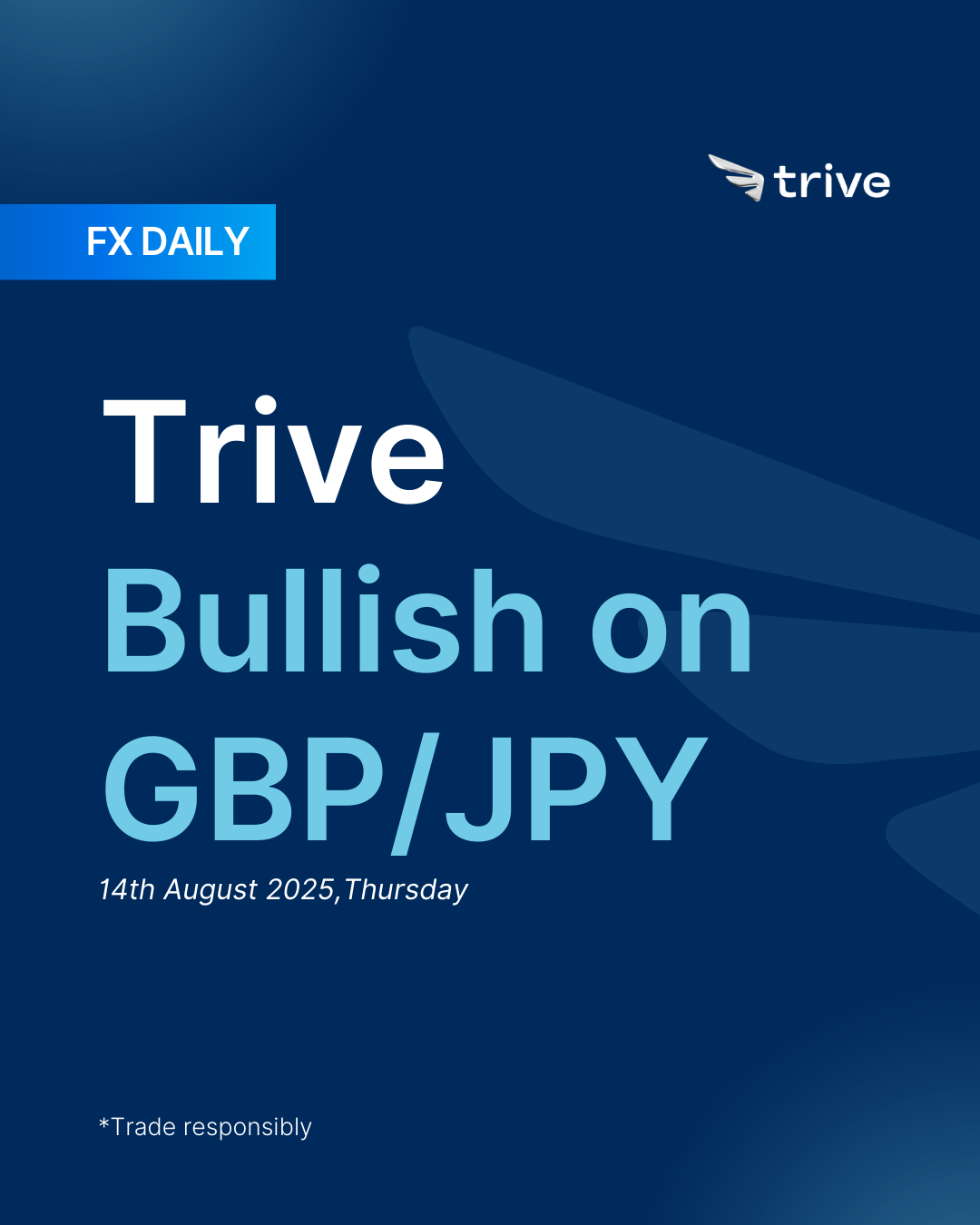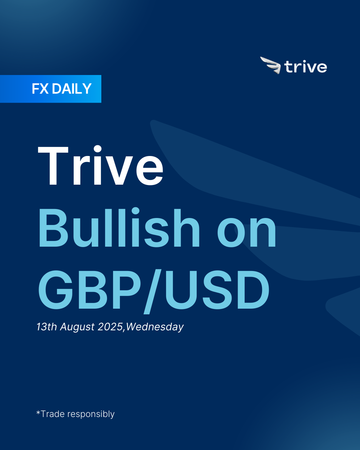FX Daily: Trive Bullish on GBP/JPY

BoE’s hawkish surprise — a narrow 5–4 vote to cut to 4.00% — slashed November cut odds, nflation risks and dissenting MPC voices signal a slower easing path, keeping Sterling underpinned near term. JPY stays weak as US yields dominate, tariff fears faded, and BoJ remains cautious despite talk of eventual hikes. With rate differentials still wide, GBP/JPY’s bias is bullish in the short term, though medium-term yen recovery risk rises if BoJ normalization firms.
GBP: Short term bullish
The British Pound broke out of its recent range this week after the Bank of England delivered an unexpected hawkish twist that forced markets to rethink the UK interest rate outlook. Sterling started the week trading quietly near 1.3300 against the dollar as investors waited for Thursday’s policy decision, with expectations firmly set on a dovish 25bps cut. While the MPC did cut rates to 4.00% as forecast, the outcome was far more hawkish than anticipated, with the decision passing on a razor-thin 5-4 vote. Four members voted to hold rates, showing a stronger-than-expected resistance to further easing. This surprise dissent shattered the assumption of a smooth, quarterly pace of cuts and sparked a sharp rally in Sterling, sending GBP/USD above 1.3400 to multi-week highs. Traders quickly scaled back bets on a November cut, leaving the Pound ending the week on much stronger ground, supported by the perception of a more inflation-focused central bank.
The BoE vote split was the key event of the week. The narrow 5-4 result was much closer than the expected 7-2, revealing a sizable hawkish faction concerned about persistent inflation. The decision required a second round of voting after an initial 4-4-1 split, with member Taylor changing his stance from a 50bps cut to a 25bps cut to break the deadlock. Following the announcement, markets aggressively reduced expectations for further cuts. The odds of a November move dropped from around 64% to below 50%, with a full 25bps cut not priced in until February 2026. Chief Economist Huw Pill, one of the dissenters, reinforced the hawkish tone on Friday, citing a rise in longer-term inflation risks and changes in price and wage-setting behavior as reasons for caution. While the MPC statement dropped its earlier guidance that policy “needs to remain restrictive,” it maintained a “gradual and careful” approach, with inflation forecasts revised higher. The statement’s softer elements were completely overshadowed by the unexpectedly close vote.
Economic data provided some minor background support. Final July PMIs were revised higher, with services rising to 51.8 and the composite to 51.5, although the impact was muted ahead of the BoE decision. On the other hand, construction activity disappointed sharply, with the sector’s PMI dropping to 44.3, showing a steep contraction. In the fiscal space, the NIESR warned that Chancellor Reeves faces a GBP 50bn shortfall in public finances that could require immediate tax hikes, but this had little influence on market pricing compared to the week’s central bank developments.
Overall, the Pound’s surge was driven almost entirely by the BoE’s hawkish surprise, with markets now expecting a slower, more cautious path of easing than previously assumed.
As of Sunday, the markets assign an 86% probability to holding rates steady and a 14% probability to a 25‐bps rate cut by the BoE at its September 18th meeting. The interest rate path is higher compared to last week, and the markets are pricing in 32‐bps of rate cuts over the next five meetings. Sterling firmed after the BoE’s hawkish surprise, with the close vote and tougher inflation tone forcing a rethink on the pace of cuts and sparking short covering before momentum cooled as growth worries and event risk crept back in.
Near term, our bias is weak bullish, the split vote and inflation risk messaging should keep dips supported while positioning normalizes, provided broader risk stays steady and incoming data doesn’t undercut the narrative.
For the longer term outlook, we lean weak bearish. Growth headwinds, the risk of a November cut, and fiscal uncertainty argue for fading strength once the BoE impulse fades, especially if global risk softens. Net-net, modest upside over the next few weeks, then a softer tone thereafter. This week’s jobs report is the swing factor: firm employment and wage momentum would validate the BoE’s caution and keep GBP supported, while any cooling would revive cut expectations and likely cap the bounce.
JPY: Remain weak for now
The Japanese Yen had a turbulent week, pulled between changing US rate expectations and uncertainty over American trade policy. USD/JPY opened under pressure, dropping below 147.00 as falling US yields after the previous week’s NFP report weighed on the pair. Mid-week, sentiment was shaken by confusion over the interpretation of new US tariffs. Initial reports suggested these duties would be “stacked” on top of existing tariffs for Japanese goods, a highly protectionist stance that pushed the pair toward 146.70. This concern eased on Friday when Japanese officials confirmed a more benign “non-stacking” interpretation from the US, meaning tariffs would not be compounded and any overcharges would be refunded. The removal of this risk allowed markets to shift their focus back to yield differentials. With US Treasury yields climbing into the weekend after a run of weak auctions, the widening gap in rates once again took control, driving USD/JPY to a new weekly high near 147.90 and highlighting the Yen’s ongoing sensitivity to US monetary policy over domestic drivers.
The tariff confusion was the most important JPY-specific development of the week. The initial “stacking” interpretation was seen as a major economic risk for Japan and pushed the Yen higher on safe-haven flows. The eventual clarification removed that headwind for Japanese exporters, turning the development into a net negative for the currency as attention shifted back to the unfavorable yield environment. Doubts over the strength of US-Japan trade ties also surfaced on Monday when Japan’s trade negotiator noted the latest trade agreement was not legally binding, though this only had a mild effect on the Yen.
Economic data provided little support. While June labour cash earnings rose by 2.5% year-on-year in line with expectations, real cash earnings fell by 1.3%, showing that inflation continued to erode household purchasing power. This reinforced the market’s view that the Bank of Japan remains in no position to tighten policy in the near term.
The Bank of Japan’s July meeting summary showed there had been some debate over resuming rate hikes, which on its own would have been mildly positive for the Yen. However, the market largely ignored this detail, focusing instead on rising US yields and trade headlines. Despite the hint of internal debate, markets continued to price around a 50% chance of a BoJ hike by year-end.
Ultimately, the Yen’s movement was dictated by shifts in US yields. Early weakness in Treasury yields limited USD/JPY upside, but their sharp rise late in the week, following poor US debt auctions, widened the US-Japan rate gap and delivered the decisive push that left the Yen weaker by the weekend.
As of Sunday, the markets assign a 60% probability to holding rates steady and a 40% probability to a 25‐bps rate hike by the BoJ at its September 19th meeting. The interest rate path is slightly lower compared to last week, and the markets are pricing in 23‐bps of rate hikes over the next five meetings.
The yen swung around last week as the narrative lurched from softer US yields to tariff confusion and back to rate differentials, the brief safe-haven bid on talk of “stacked” US tariffs, meaning new duties would be added on top of existing ones rather than replacing them, effectively compounding the total tariff rate, faded once officials clarified a non-stacking approach, and with Treasury yields pushing higher into the weekend, the dollar–yen rate re-accelerated with US policy still doing most of the steering while domestic inputs were largely sidelined.
Near term, the balance feels mixed but tilting slightly bearish for JPY, with the BoJ still cautious and US yields in the driver’s seat, rallies in the yen look fragile unless risk sentiment sours or the US curve relents; headline noise on trade seems less threatening after the clarification, which keeps the focus on yield spreads and the market’s modestly higher path for US rates.
For the longer term outlook, we lean bullish on JPY, better domestic demand and looser fiscal support give the BoJ room to resume gradual normalization, and a modest hike later in the year would start nudging rate differentials in the right direction, add in stretched valuation and the chance of a broader shift toward Fed easing, and the medium-term skew points to a stronger yen, albeit in a slow grind rather than a straight line.
Overall, a choppy few weeks with a slight downside bias for JPY, then a firmer profile into the next quarter if the BoJ normalization story firms up. This week’s PPI and GDP matter because they speak to that path, hotter producer prices and solid growth would bolster the case for resumed hikes and support the yen, while softer prints would sap conviction, keep the BoJ in wait-and-see mode, and leave the currency at the mercy of US yield swings.
If the macro outlook shifts to one where the US economy weakens just enough to justify rate cuts, but not enough to trigger broader risk aversion, we actually think the Yen could underperform. In that kind of environment, high beta currencies like the Australian Dollar are more likely to benefit from the combination of lower US yields and improving risk sentiment. The market might then shift its focus back to yield differentials and growth prospects, where the Yen continues to lag. So while the post NFP move felt like a turning point, we see room for fresh JPY weakness if we settle into a softer US narrative that still favors carry and pro cyclical flows.

GBP/JPY 4H
Disclaimer
This material is provided for informational purposes only and does not constitute financial, investment, or other advice. The opinions expressed in this material are those of the author and do not necessarily reflect the views of Trive International. No opinion contained in this material constitutes a recommendation by Trive International or its author regarding any particular investment, transaction, or investment strategy. This material should not be relied upon in making any investment decision.
The information provided does not consider the individual investment objectives, financial situation, or needs of any specific investor. Investors should seek independent financial advice tailored to their individual circumstances before making any investment decisions. Trive International shall not be liable for any loss, damage, or injury arising directly or indirectly from the use of this information or from any action or decision taken as a result of using this material.
Trive International may or may not have a financial interest in the companies or securities mentioned. The value of investments may fluctuate, and investors may not get back the amount they originally invested. Past performance is not indicative of future results.
For more information about Trive International, please visit http://trive.com/int
Additional Information
Investing involves risk, including the potential loss of principal. Diversification and asset allocation strategies do not ensure a profit or guarantee against loss. The content in this material is subject to change without notice and may become outdated or inaccurate over time. Trive International does not undertake any obligation to update the information in this material.
By accessing this material, you acknowledge and agree to the terms of this disclaimer. If you do not agree with these terms, please refrain from using this information.
कोई टिप्पणी नहीं
Home
Trive
TriveHub





0 टिप्पणियाँ